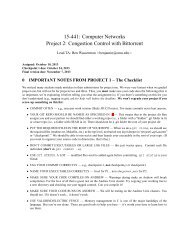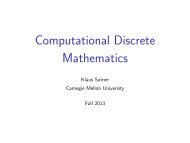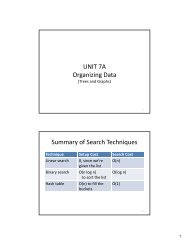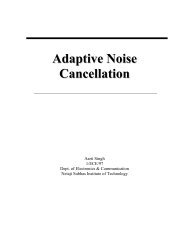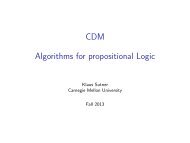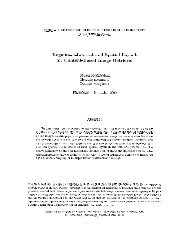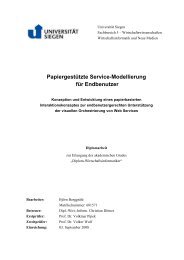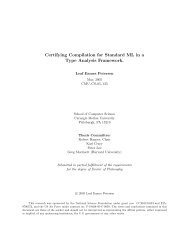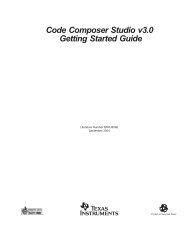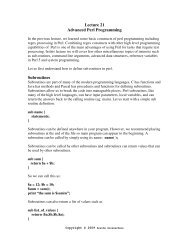Building and Learning from a Contextual Knowledge Base for a ...
Building and Learning from a Contextual Knowledge Base for a ...
Building and Learning from a Contextual Knowledge Base for a ...
Create successful ePaper yourself
Turn your PDF publications into a flip-book with our unique Google optimized e-Paper software.
<strong>Building</strong> <strong>and</strong> <strong>Learning</strong> <strong>from</strong> a <strong>Contextual</strong> <strong>Knowledge</strong> <strong>Base</strong> <strong>for</strong> a<br />
Personalized Physical Therapy Coach<br />
Robert Fisher<br />
Thomas Kollar<br />
Reid Simmons<br />
Carnegie Mellon University, 5000 Forbes Ave, Pittsburgh, PA 15213<br />
rwfisher@cs.cmu.edu<br />
tkollar@cs.cmu.edu<br />
reids@cs.cmu.edu<br />
Abstract<br />
Robotic systems that interact with humans<br />
must modify <strong>and</strong> personalize their behavior<br />
based on contextual in<strong>for</strong>mation if we wish<br />
<strong>for</strong> them to be effective. In this paper, we<br />
present a novel learning framework <strong>for</strong> collecting<br />
<strong>and</strong> utilizing in<strong>for</strong>mation in a <strong>Contextual</strong><br />
<strong>Knowledge</strong> <strong>Base</strong>. This knowledge base<br />
can be used to represent in<strong>for</strong>mation that is<br />
unique to a given user <strong>and</strong> environment, <strong>and</strong><br />
the contents of the knowledge base can be<br />
used as input to a learning algorithm to personalize<br />
the behavior of the system to the<br />
current context. We present preliminary results<br />
when using this framework as part of a<br />
physical therapy exercise coach.<br />
1. Introduction<br />
<strong>Contextual</strong> <strong>and</strong> personal in<strong>for</strong>mation is a critical element<br />
in human interactions but is often ignored by<br />
applications in the field of human-robot interaction.<br />
In particular, if a robot is tasked with coaching a user<br />
through physical therapy exercises, a stern approach<br />
may be most appropriate <strong>for</strong> some users in some contexts,<br />
while other situations may call <strong>for</strong> a gentler style<br />
of coaching. To accomplish this, the robot must first<br />
build a model of the current user <strong>and</strong> environment, <strong>and</strong><br />
then learn the most appropriate action <strong>for</strong> the given<br />
context.<br />
<strong>Contextual</strong> in<strong>for</strong>mation can be collected using sensor<br />
processing algorithms applied to the output of sensors<br />
such as infrared range cameras, GPS, RGB cameras,<br />
or accelerometers. Some contextual in<strong>for</strong>mation<br />
can also be acquired directly through language. For<br />
Proceedings of the 30 th International Conference on Machine<br />
<strong>Learning</strong>, Atlanta, Georgia, USA, 2013. JMLR:<br />
W&CP volume 28. Copyright 2013 by the author(s).<br />
instance, if a dialogue agent wished to learn the<br />
gender or age of a conversation partner, it could<br />
conduct inference on audio <strong>and</strong> video data—or it<br />
could simply ask the user.<br />
In this work, we propose methods <strong>for</strong> building <strong>and</strong><br />
utilizing a <strong>Contextual</strong> <strong>Knowledge</strong> <strong>Base</strong> (CKB) that<br />
contains all the in<strong>for</strong>mation an interactive agent has<br />
acquired about its user <strong>and</strong> the environment. Unlike<br />
large scale knowledge bases like NELL (Carlson, 2010)<br />
<strong>and</strong> Freebase (Bollacker et al., 2008), the in<strong>for</strong>mation<br />
in a <strong>Contextual</strong> <strong>Knowledge</strong> <strong>Base</strong> must be collected in<br />
an online setting <strong>for</strong> each individual user of the system.<br />
The contextual knowledge base consists of a set<br />
of expressions <strong>from</strong> a machine-readable Meaning Representation<br />
Language (MRL). The expressions can be<br />
acquired through conversation, analysis of sensor data,<br />
or some combination of the two. Once the CKB has<br />
been assembled, it can be used as input to a learning<br />
algorithm which will predict the best action <strong>for</strong> the<br />
agent to take in the given setting.<br />
As a testbed application <strong>for</strong> this context aware language<br />
system, we are investigating a virtual coaching<br />
system that will help people who have suffered <strong>from</strong><br />
a stroke to conduct physical therapy exercises in their<br />
homes. This coaching system is be equipped with sensing<br />
capabilities provided by a Microsoft Kinect, which<br />
allows the system to visually perceive the environment,<br />
conduct activity recognition, <strong>and</strong> interact with users<br />
through a verbal dialogue. Table 1 shows some examples<br />
of expressions that may occur in the <strong>Contextual</strong><br />
<strong>Knowledge</strong> <strong>Base</strong>. We see <strong>from</strong> these examples<br />
that time plays a more important role in a <strong>Contextual</strong><br />
<strong>Knowledge</strong> <strong>Base</strong> than other knowledge bases. Some<br />
entries in the CKB, such as which activity the user is<br />
currently per<strong>for</strong>ming, will be true only <strong>for</strong> a very short<br />
time period. There<strong>for</strong>e, it may be beneficial to index<br />
the knowledge base by time, though we do not address<br />
the temporal dimension of the CKB in this paper.
<strong>Building</strong> <strong>and</strong> <strong>Learning</strong> <strong>from</strong> a <strong>Contextual</strong> <strong>Knowledge</strong> <strong>Base</strong> <strong>for</strong> a Personalized Physical Therapy Coach<br />
CKB Entry<br />
MRL<br />
User is 42 years old<br />
user age(42)<br />
User is currently<br />
conducting exercise 4 current activity(exercise4)<br />
User reported pain<br />
level of 9 on the Likert likert pain(9, exercise 2)<br />
scale during exercise 2<br />
User’s arm was too<br />
high during exercise 1 incorrect(exercise1, high arm)<br />
Table 1. <strong>Contextual</strong> <strong>Knowledge</strong> <strong>Base</strong> Examples<br />
There are many potential applications <strong>for</strong> a <strong>Contextual</strong><br />
<strong>Knowledge</strong> <strong>Base</strong>. In this paper, we will discuss<br />
how to use the CKB to learn a policy <strong>for</strong> personalized<br />
interactions that the exercise coach takes with a<br />
given user. For example, the coach could request the<br />
user to conduct a variable number of reps of a given<br />
exercise depending the user’s proclivity towards that<br />
exercise, the user’s current physical or mental state,<br />
or the exercise goals set <strong>for</strong>th by a clinician. A clinician<br />
supervising the user’s physical therapy could also<br />
query the knowledge base <strong>and</strong> concerning trends observed<br />
by the system during physical therapy could be<br />
brought to the clinician’s attention.<br />
In this paper, we propose using natural language as<br />
a means of acquiring in<strong>for</strong>mation to be added to the<br />
knowledge base. Some in<strong>for</strong>mation that we would like<br />
to track in the CKB, such as a record of the user’s<br />
dietary habits, would be difficult or impossible to acquire<br />
using sensor processing. Because the CKB contains<br />
in<strong>for</strong>mation represented in the same language as<br />
the semantic parser output, it is straight-<strong>for</strong>ward to<br />
add this in<strong>for</strong>mation directly to the database. Additionally,<br />
there are instances in which the correct parse<br />
<strong>for</strong> a given sentence will depend on the current contents<br />
of the CKB. For example, if the user says “I<br />
want to do this exercise”, it is impossible to underst<strong>and</strong><br />
the referent of the statement without additional<br />
in<strong>for</strong>mation. However, the activity recognition software<br />
can add an item to the CKB which tells us that<br />
the user has begun per<strong>for</strong>ming a leg exercise, which<br />
would allow us to disambiguate the meaning of the<br />
input. If we were given this sentence <strong>and</strong> the CKB<br />
shown in Table 1, the target MRL statement would be<br />
user request(begin(exercise4)).<br />
Due to the limited amount of labeled textual <strong>and</strong> contextual<br />
data in the physical therapy coaching domain,<br />
a semantic parser <strong>for</strong> this application will be reliant on<br />
human annotators to provide training data <strong>for</strong> the system.<br />
Because annotation is a bottleneck in the training<br />
of the system, we also introduce a decision theoretic,<br />
active learning scheme to make efficient use of a<br />
small number of annotations applied to a large set of<br />
unlabeled data.<br />
2. Related work<br />
Work in building knowledge bases through in<strong>for</strong>mation<br />
extraction often focuses on examining large corpuses of<br />
text data (Carlson et al., 2010; Bollacker et al., 2008).<br />
The items in the knowledge base are often thought of<br />
as the output of a semantic parser, but there has also<br />
been some work to use the contents of a knowledge<br />
base in the training of a semantic parser (Krishnamurthy<br />
& Mitchell, 2012).<br />
There has been some recent work using sensing technology,<br />
particularly smartphones, to establish models<br />
of context (Fisher & Simmons, 2011; Lane et al., 2010).<br />
Most of these approaches do not utilize natural language<br />
underst<strong>and</strong>ing to acquire contextual in<strong>for</strong>mation.<br />
A great deal of work has focused on representing conversational<br />
context <strong>for</strong> dialogue systems (Morbini &<br />
Sagae, 2011), but there is a significant opportunity to<br />
couple work in sensory, context awareness with natural<br />
language dialogue systems.<br />
Active learning has been a popular topic in machine<br />
learning <strong>for</strong> quite some time, but it has only recently<br />
begun to be popularized in natural language processing<br />
applications (Settles, 2010).<br />
Other social coaching robots have demonstrated that<br />
personalization is an important factor in user acceptance(Fasola<br />
& Mataric, 2012; Kidd & Breazeal, 2008),<br />
but the personalization elements of these systems generally<br />
react only to a few, limited pieces of in<strong>for</strong>mation<br />
such as the user’s name. One study that directly<br />
compared a robot with personalized social interactions<br />
with generic social interactions demonstrated that the<br />
personalized interactions resulted in more active user<br />
engagement, better rapport, <strong>and</strong> increased levels of<br />
user cooperation(Lee et al., 2012).<br />
3. Method<br />
In this paper, we will exp<strong>and</strong> on a previously established<br />
semantic parsing framework(Clarke et al., 2010)<br />
by incorporating a contextual knowledge base, CKB,<br />
as well as active learning to expedite training of the<br />
parser. In this section, we will give a basic overview<br />
of the semantic parser <strong>and</strong> describe how we have integrated<br />
the parser with the CKB. We will then discuss a<br />
method <strong>for</strong> building personalized models, which would<br />
allow an agent to select the most appropriate action<br />
<strong>for</strong> a given context according to a cost function.<br />
3.1. Semantic Parsing with the CKB<br />
In this semantic parsing task, we begin with an ontology,<br />
O, which consists of a set of concepts <strong>and</strong><br />
functions operating over those concepts (such as the<br />
function user age(), or the concept exercise2). Dur-
<strong>Building</strong> <strong>and</strong> <strong>Learning</strong> <strong>from</strong> a <strong>Contextual</strong> <strong>Knowledge</strong> <strong>Base</strong> <strong>for</strong> a Personalized Physical Therapy Coach<br />
Example 1 Example 2<br />
Sentence<br />
Sentence<br />
How am I doing?<br />
I would rate my pain<br />
as a 5 during exercise 2.<br />
CKB<br />
CKB<br />
current activity(exercise3) current activity(idle)<br />
user age(42)<br />
user gender(male)<br />
likert pain(exercise1, 9) last question(query(user pain))<br />
Target MRL<br />
Target MRL<br />
request(assess(exercise3)) likert pain(exercise2, 5)<br />
Table 2. Input Data Examples<br />
ing parsing, we are given a natural language sentence,<br />
S, as well as the <strong>Contextual</strong> <strong>Knowledge</strong> <strong>Base</strong>—which<br />
consists of a set of statement created by composing<br />
elements of the ontology together. The goal is to construct<br />
a semantically equivalent MRL statement using<br />
the items in the ontology. Table 2 gives two concrete<br />
examples of sample input <strong>and</strong> desired output.<br />
To accomplish the semantic parsing task, we will define<br />
two smaller two subtasks 1) determine which elements<br />
of the ontology are present in the target MRL<br />
statement 2) compose those elements together in a directed,<br />
acyclic arrangement. The first summation in<br />
the objective function shown in Table 3 relates to task<br />
1, while the second summation relates to task 2.<br />
We will first address how to determine which items<br />
<strong>from</strong> the ontology are present in the target MRL. We<br />
begin with a set of constituents, which consist of single<br />
words <strong>from</strong> the input sentence, phrases <strong>from</strong> the<br />
input sentence, <strong>and</strong> items <strong>from</strong> the contextual knowledge<br />
base. We will denote X = (s, ckb) are the pair<br />
containing the input sentence <strong>and</strong> the current contextual<br />
knowledge base. X can be thought of as a structured<br />
set, which contains all the constituents, but also<br />
the syntax of the input sentence. Each constituent<br />
taken <strong>from</strong> X will have a similarity score <strong>for</strong> each<br />
item in the ontology. For constituents taken <strong>from</strong> the<br />
sentence, a lexical similarity function (Clarke et al.,<br />
2010) is used to compute this similarity. For example,<br />
if the word “car” appears in the sentence, it would<br />
have much higher similarity to an item in the ontology<br />
called “vehicle” than an item in the ontology<br />
called “house.” Constituents taken <strong>from</strong> the contextual<br />
knowledge base will have high similarity to items<br />
in the ontology if the given item <strong>from</strong> the ontology is<br />
present in the CKB element. For instance, if the CKB<br />
tells us that the user is currently per<strong>for</strong>ming exercise<br />
4, the likelihood the the concept exercise4 appears in<br />
the MRL increases. For each constituent c <strong>and</strong> ontology<br />
item s we denote the similarity score between<br />
these items as Φ 1 (X, c, s). Additionally, there will be<br />
a weight w c,s which is learned with annotated training<br />
data using a structured support vector machine.<br />
Now we consider composing the items <strong>from</strong> the ontology<br />
together to <strong>for</strong>m an expression in the MRL.<br />
We will leverage a structured ontology with type constraints.<br />
For instance, we would know a priori that<br />
the item user age in the ontology is a function that<br />
takes a number as an argument. There<strong>for</strong>e, a pair of<br />
items <strong>from</strong> the ontology, s <strong>and</strong> t, can only be composed<br />
together as s(t) if s is a function that can take<br />
t’s type as an argument. Given constituents, c <strong>and</strong> d,<br />
<strong>and</strong> ontology item s <strong>and</strong> t, we denote the composition<br />
score of s(t) as Φ 2 (X, c, d, s, t). This composition score<br />
is always 0 if s(t) is not a valid composition. If s(t)<br />
is valid, <strong>and</strong> the constituents c <strong>and</strong> d are taken <strong>from</strong><br />
the sentence, Φ 2 (X, c, d, s, t) will be the distance in the<br />
dependency tree between c <strong>and</strong> d.<br />
We must also account <strong>for</strong> the case when one or both<br />
of the constituents are taken <strong>from</strong> the CKB, <strong>and</strong> syntactic<br />
in<strong>for</strong>mation is there<strong>for</strong>e unavailable. We operate<br />
under the assumption that context should only be<br />
used in the creation of the semantic representation if<br />
the language of the input sentence is ambiguous. For<br />
example, if the input sentence is “how am I doing?”,<br />
a CKB item that indicates that the user is currently<br />
per<strong>for</strong>ming a certain exercise could be used to disambiguate<br />
the referent of the question. However, if the<br />
sentence instead is “how am I doing on exercise 3?”,<br />
we do not need to consult the CKB to disambiguate<br />
the input, <strong>and</strong> the response should be the same regardless<br />
of which activity the user is currently conducting.<br />
There<strong>for</strong>e, the composition scores <strong>for</strong> CKB<br />
items are smaller than the corresponding composition<br />
scores <strong>for</strong> constituents taken <strong>from</strong> the input sentence.<br />
Once again, there are also a set of weights w c,d,s,t that<br />
are trained using labeled data.<br />
Given the scoring functions Φ 1 <strong>and</strong> Φ 2 , as well as the<br />
parameter weights w, we use an integer linear program<br />
to find the best possible MRL given <strong>and</strong> input <strong>and</strong> the<br />
current parameterization. The objective function <strong>and</strong><br />
constraints of the integer linear program are given in<br />
Table 3. In this <strong>for</strong>mulation, we have a binary variable<br />
α cs <strong>for</strong> each constituent c <strong>and</strong> ontology item s.<br />
If this variable is set to 1 by the ILP, this indicates<br />
that this constituent maps to this ontology item, <strong>and</strong><br />
the ontology item s is present in the final MRL. The<br />
binary variable β cs,dt indicates that ontology items s<br />
<strong>and</strong> t are composed as s(t). The variable β cs,dt can<br />
only be set to 1 if α cs = 1 <strong>and</strong> α dt = 1. All α <strong>and</strong> β<br />
variables will have values assigned by the integer linear<br />
program. More detail about this framework can<br />
be found in (Clarke et al., 2010).<br />
3.2. Active <strong>Learning</strong><br />
To train the semantic parser, we utilize a decision theoretic<br />
approach that allows the parser to select <strong>from</strong> two<br />
different types of questions. In the first type of ques-
<strong>Building</strong> <strong>and</strong> <strong>Learning</strong> <strong>from</strong> a <strong>Contextual</strong> <strong>Knowledge</strong> <strong>Base</strong> <strong>for</strong> a Personalized Physical Therapy Coach<br />
∑Maximize:<br />
∑<br />
f(X) = α cs · w T Φ 1(X, c, s)<br />
∑ ∑c∈X<br />
s∈O<br />
+<br />
β cs,dt · w T Φ 2(X, c, d, s, t)<br />
c,d∈X s,t∈O<br />
Objective Function<br />
Subject to:<br />
∀(c, s) α c,s ∈ {0, 1}<br />
∀(c, d, s, t) βcs, dt ∈ {0, 1}<br />
(All variables are binary)<br />
Constraint I<br />
∑<br />
∀c α c,s = 1<br />
s∈D<br />
(Every constituent mapped to exactly<br />
one item in Ontology)<br />
Constraint II<br />
α c,s<br />
∀(c, d, s, t) + α d,t<br />
≥ β<br />
2 2 cs,dt<br />
(An ontological combination can only be<br />
active if both its constituents are active)<br />
Constraint III<br />
Table 3. Integer Linear Program Formulation<br />
tion, the annotator is given a sentence, an instance of<br />
a CKB, <strong>and</strong> an MRL, <strong>and</strong> the annotator must determine<br />
if the given MRL is correct <strong>for</strong> the given input.<br />
The annotator then provides a binary label indicating<br />
if the semantic representation is correct. In the second<br />
type of question, the annotator is given only the<br />
sentence <strong>and</strong> the CKB, <strong>and</strong> is asked to provide the correct<br />
MRL. Clearly the second type of the question will<br />
be more time consuming <strong>for</strong> the annotator, so these<br />
questions have an elevated cost associated with them<br />
in the active learning algorithm.<br />
There will be one active learning metric <strong>for</strong> each of the<br />
two question types. These metrics are computed <strong>for</strong><br />
each instance in a large unlabeled corpus.<br />
We will use the value of the objective function defined<br />
in Table 3 as a proxy <strong>for</strong> the confidence of the semantic<br />
parser <strong>for</strong> a given sentence, CKB pair. We will<br />
denote this confidence as f(X). It is worth noting here<br />
that when asking <strong>for</strong> binary feedback <strong>from</strong> an annotator,<br />
correct parses are much more in<strong>for</strong>mative because<br />
the correct MRL is implicitly included with the label.<br />
However, when asking <strong>for</strong> a full annotation, inputs <strong>for</strong><br />
which the parser is currently highly uncertain are most<br />
in<strong>for</strong>mative.<br />
density(X) = ∑ ∑ 1 ∑<br />
D(c, d)<br />
|Y i |<br />
c∈X Y i d∈Y i<br />
Density<br />
In addition to confidence, we will also consider how<br />
representative a given input is when compared to the<br />
whole unlabeled corpus. For given input X, we compare<br />
the similarity of X to all other inputs in the<br />
corpus, Y . We use normalized lexical similarity between<br />
words to compute the similarity of these sentences.<br />
The lexical similarity of words c <strong>and</strong> d is denoted<br />
D(c, d). We assume that X <strong>and</strong> Y i have already<br />
been syntactically parsed, the constituents have been<br />
chunked, <strong>and</strong> determiners <strong>and</strong> conjunctions have been<br />
removed.<br />
W D 1 (X) = f(X) · density(X)<br />
W D 2 (X) = δ ·<br />
1<br />
f(X) · density(X)<br />
Active <strong>Learning</strong> Metrics<br />
W D 1 <strong>and</strong> W D 2 represent the two active<br />
metrics—W D 1 is used to score a binary annotation,<br />
while W D 2 is used to score a complete<br />
annotation. The parameter δ denotes the cost of<br />
asking <strong>for</strong> a complete annotation. This cost has<br />
been estimated to be around 20, based on the time<br />
required to produce a whole MRL compared to simply<br />
validated a given MRL.<br />
3.3. Personalization<br />
Now we turn to the problem of personalizing the behavior<br />
of the system given a contextual knowledge base<br />
instance. The task here is to select an action a <strong>from</strong><br />
a finite set of actions A to minimize a cost function<br />
C(a, CKB). The state-space of the contextual knowledge<br />
base is very large <strong>and</strong> sparse. Furthermore, the<br />
cost of taking an action with a given CKB may differ<br />
between users. For the physical therapy coach, the<br />
cost of taking an action will be a function of the user’s<br />
response to the action. If the action taken by the coach<br />
is to sternly tell a user to do one more repetition of an<br />
exercise, the cost of the action will be 0 if the user does<br />
the exercise <strong>and</strong> does it correctly, while the cost will be<br />
much greater if the exercise is per<strong>for</strong>med incorrectly or<br />
not at all. The set of actions includes giving feedback<br />
<strong>and</strong> instruction to a user, allowing the system to issue<br />
a given instruction in different ways, e.g. aggressively<br />
or supportively.<br />
To personalize the coaching system, we train a conditional<br />
r<strong>and</strong>om field (CRF) with features extracted<br />
<strong>from</strong> the contextual knowledge base. Each feature<br />
will be a logical statement consisting of elements<br />
of the CKB joined with conjunctions, disjunctions,<br />
<strong>and</strong> negations, <strong>for</strong> example [user gender(male) ∧<br />
current activity(exercise4)]. A feature will have a<br />
value of 1 <strong>for</strong> given knowledge base if <strong>and</strong> only if the assertion<br />
encoded by the feature evaluates to true in the
<strong>Building</strong> <strong>and</strong> <strong>Learning</strong> <strong>from</strong> a <strong>Contextual</strong> <strong>Knowledge</strong> <strong>Base</strong> <strong>for</strong> a Personalized Physical Therapy Coach<br />
current knowledge base. We can think of the space of<br />
all such logical assertions <strong>for</strong>med using CKB entries as<br />
a lattice, wherein statements containing only a single<br />
CKB statement lie at the bottom level of the lattice.<br />
During training, all features in the lowest k levels of<br />
the lattice (all first-order logical statements with at<br />
most k terms) are considered, <strong>and</strong> L1 regularization is<br />
used to constrain the feature space.<br />
The system will initially use a baseline model trained<br />
on many users to select actions, <strong>and</strong> this model will<br />
slowly be replaced by a model trained post-deployment<br />
based on a given user’s interactions with the system.<br />
To capture this, we will have two weight vectors: W B<br />
contains the baseline weights, <strong>and</strong> W P contains the<br />
personalized weights. Only those elements of the feature<br />
lattice with non-zero W B weights are used when<br />
training W P . The personalized weight vector is further<br />
scaled by a parameter γ, which increases as more<br />
data becomes available <strong>for</strong> the current user, thus allowing<br />
the personalized model to slowly replace the<br />
baseline model.<br />
4. Results<br />
In this section, we present preliminary experimental<br />
results when using the semantic parser <strong>and</strong> personalization<br />
algorithms.<br />
For the semantic parser, we collected 98 natural language<br />
sentences, with each sentence accompanied by<br />
its own CKB. The CKB inputs <strong>for</strong> these tests were artificially<br />
created <strong>for</strong> the purposes of testing <strong>and</strong> training<br />
the semantic parser. Each of the 98 inputs also has a<br />
manually created target MRL statement accompanying<br />
it.<br />
Input sentences included statements about pain levels<br />
<strong>for</strong> an exercise, user requests to start or stop an<br />
exercise, responses to queries <strong>for</strong> personal in<strong>for</strong>mation<br />
(like age, gender, <strong>and</strong> weight), <strong>and</strong> requests <strong>for</strong> feedback<br />
<strong>from</strong> the coaching system <strong>for</strong> a given exercise.<br />
The CKB inputs included statements such as current<br />
<strong>and</strong> previous user activity, MRL statement of last utterance<br />
by the system <strong>and</strong> user, reported pain levels<br />
<strong>for</strong> various exercises, personal in<strong>for</strong>mation, <strong>and</strong> current<br />
date <strong>and</strong> time.<br />
The weights <strong>for</strong> the semantic parser were trained using<br />
a structured SVM algorithm. For evaluation, we<br />
used 50 rounds of cross-validation, with 75 r<strong>and</strong>omly<br />
selected questions held out <strong>for</strong> testing in each round.<br />
Figure 1(a) shows the training curve with <strong>and</strong> without<br />
active learning enabled, with the X axis indicating the<br />
number of questions the system was allowed to ask,<br />
<strong>and</strong> the Y axis indicates the average parsing accuracy.<br />
With active learning enabled, the metrics described in<br />
section 3.2 were used to determine which input in the<br />
training data the system would request, <strong>and</strong> whether<br />
it would request a full MRL or binary feedback on it’s<br />
current prediction. Without active learning enabled,<br />
the system was r<strong>and</strong>omly given labels <strong>from</strong> the training<br />
data, with a 20% chance of being given a full MRL,<br />
<strong>and</strong> 80% of being given binary feedback.<br />
For the personalization CRF, we simulated a dataset<br />
with each row consisting of an action, a CKB, <strong>and</strong> a<br />
cost. Ten different distributions of C(a, CKB) were<br />
defined, with each distribution representing a single,<br />
simulated user of the system. R<strong>and</strong>om samples were<br />
taken <strong>from</strong> each distribution to construct the dataset.<br />
The evaluation of the algorithm consisted of 10 stages.<br />
In each stage, the algorithm was given all of the data<br />
<strong>from</strong> 9 of the distributions with which to train W B .<br />
W P was trained on 10% of the samples <strong>from</strong> the remaining<br />
distribution, <strong>and</strong> then asked to predict the<br />
cost of the remaining 90% of the samples <strong>from</strong> this<br />
distribution. Figure 1(b) shows the average cost of<br />
the actions chosen by the system as a function of the<br />
number of training samples provided.<br />
4.1. Analysis<br />
We begin by considering the semantic parsing results.<br />
Many of the sentences in the testing data would have<br />
been impossible to correctly parse without the corresponding<br />
CKB entries, <strong>and</strong> we see <strong>from</strong> Figure 1(a)<br />
that the active learning algorithm generally improved<br />
the parsing accuracy compared to r<strong>and</strong>om sampling.<br />
We see that when n ≥ 4, the increase in accuracy when<br />
using active learning is always statistically significant.<br />
We observed consistent trends in the learned values<br />
of the parsing weights across many iterations in<br />
the cross validation. In particular, the weights <strong>for</strong><br />
current activity() <strong>and</strong> last question() expressions in<br />
the CKB directly affected the target MRL statement<br />
in many training examples, <strong>and</strong> thus, these CKB entries<br />
received rather large weights. CKB entries related<br />
to personal in<strong>for</strong>mation, such as Likert pain levels<br />
<strong>and</strong> user age, nearly always ended training with<br />
weights close to 0. This is unsurprising, because within<br />
the scope of these experiments, these features do not<br />
directly in<strong>for</strong>m the content of the target MRLs, but<br />
many of these CKB entries appeared in many features<br />
selected by the personalization algorithm.<br />
With the personalization experiments, we used a set<br />
of 60 possible CKB entries. When searching the feature<br />
lattice, we only considered logical statements with<br />
k = 10 or fewer terms. This still resulted in more than<br />
1 million possible features, but the vast majority of<br />
these features never appeared in any instance in the<br />
dataset. On average, between 100 <strong>and</strong> 300 features received<br />
non-zero weights in W B when L1 regularization
<strong>Building</strong> <strong>and</strong> <strong>Learning</strong> <strong>from</strong> a <strong>Contextual</strong> <strong>Knowledge</strong> <strong>Base</strong> <strong>for</strong> a Personalized Physical Therapy Coach<br />
Parsing Accuracy<br />
95<br />
90<br />
85<br />
80<br />
75<br />
Active <strong>Learning</strong><br />
R<strong>and</strong>om Sampling<br />
Average cost<br />
5.5<br />
5<br />
4.5<br />
4<br />
3.5<br />
3<br />
2.5<br />
2<br />
1.5<br />
70<br />
0 5 10 15<br />
Number of training samples<br />
(a) Semantic Parsing<br />
1<br />
0.5<br />
0 500 1000 1500 2000 2500<br />
Number of training instances (90% baseline, 10% personalized)<br />
(b) Personalization<br />
Figure 1. Results<br />
was applied.<br />
R<strong>and</strong>omly picking an action would result in an expected<br />
cost C(a, CKB) = 5. We see <strong>from</strong> figure 1(b)<br />
that the knee of the cost curve occurs at around 400<br />
data points, with 40 of those being taken <strong>from</strong> the user<br />
with which the system is interacting. We could realistically<br />
expect to see this many interactions with a user<br />
of a physical therapy coaching system over the course<br />
of a few weeks, so we feel that these results indicate<br />
that creating personalized interactions will be viable<br />
in this domain.<br />
5. Future Work<br />
The results we have seen within this paper regarding<br />
the building <strong>and</strong> usage of a <strong>Contextual</strong> <strong>Knowledge</strong><br />
<strong>Base</strong> are promising, but there is a great deal of system<br />
integration remaining to be done be<strong>for</strong>e a complete<br />
system can be deployed <strong>for</strong> evaluation.<br />
While the results we have seen using active learning<br />
in this work are promising, human annotation continues<br />
to be a bottleneck in the training of a context<br />
aware semantic parser. Future work may explore new<br />
methods of acquiring feedback in<strong>for</strong>mation <strong>from</strong> human<br />
annotators, such as allowing human annotators<br />
presented with a c<strong>and</strong>idate MRL statement to pinpoint<br />
to a learning algorithm exactly which part of the<br />
MRL requires adjustment. Alternatively, the weaker<br />
<strong>for</strong>ms of training that do not require an expert annotator<br />
(such as giving binary feedback on a input/output<br />
pair) could be crowdsourced.<br />
Going <strong>for</strong>ward, we feel that <strong>Contextual</strong> <strong>Knowledge</strong><br />
<strong>Base</strong>s represent an exciting framework <strong>for</strong> incorporating<br />
language with context awareness <strong>and</strong> personalization,<br />
but there are many open research questions that<br />
need to be addressed be<strong>for</strong>e this technology can prove<br />
its full potential.<br />
References<br />
Bollacker, Kurt, Evans, Colin, Paritosh, Praveen,<br />
Sturge, Tim, <strong>and</strong> Taylor, Jamie. Freebase: a collaboratively<br />
created graph database <strong>for</strong> structuring<br />
human knowledge. In Proceedings of the 2008 ACM<br />
SIGMOD international conference on Management<br />
of data, pp. 1247–1250. ACM, 2008.<br />
Carlson, Andrew, Betteridge, Justin, Kisiel, Bryan,<br />
Settles, Burr, Hruschka Jr, Estevam R, <strong>and</strong><br />
Mitchell, Tom M. Toward an architecture <strong>for</strong> neverending<br />
language learning. In Proceedings of the<br />
Twenty-Fourth Conference on Artificial Intelligence<br />
(AAAI 2010), volume 2, pp. 3–3, 2010.<br />
Clarke, James, Goldwasser, Dan, Chang, Ming-Wei,<br />
<strong>and</strong> Roth, Dan. Driving semantic parsing <strong>from</strong><br />
the world’s response. In Proceedings of the Fourteenth<br />
Conference on Computational Natural Language<br />
<strong>Learning</strong>, pp. 18–27. Association <strong>for</strong> Computational<br />
Linguistics, 2010.<br />
Fasola, Juan <strong>and</strong> Mataric, Maja J. Using socially assistive<br />
human–robot interaction to motivate physical<br />
exercise <strong>for</strong> older adults. Proceedings of the IEEE,<br />
100(8):2512–2526, 2012.<br />
Fisher, Robert <strong>and</strong> Simmons, Reid. Smartphone<br />
interruptibility using density-weighted uncertainty<br />
sampling with rein<strong>for</strong>cement learning. In Machine<br />
<strong>Learning</strong> <strong>and</strong> Applications <strong>and</strong> Workshops<br />
(ICMLA), 2011 10th International Conference on,<br />
volume 1, pp. 436–441. IEEE, 2011.<br />
Kidd, Cory D <strong>and</strong> Breazeal, Cynthia. Robots at home:
<strong>Building</strong> <strong>and</strong> <strong>Learning</strong> <strong>from</strong> a <strong>Contextual</strong> <strong>Knowledge</strong> <strong>Base</strong> <strong>for</strong> a Personalized Physical Therapy Coach<br />
Underst<strong>and</strong>ing long-term human-robot interaction.<br />
In Intelligent Robots <strong>and</strong> Systems, 2008. IROS 2008.<br />
IEEE/RSJ International Conference on, pp. 3230–<br />
3235. IEEE, 2008.<br />
Krishnamurthy, Jayant <strong>and</strong> Mitchell, Tom M. Weakly<br />
supervised training of semantic parsers. In Proceedings<br />
of the 2012 Joint Conference on Empirical<br />
Methods in Natural Language Processing <strong>and</strong> Computational<br />
Natural Language <strong>Learning</strong>, pp. 754–765.<br />
Association <strong>for</strong> Computational Linguistics, 2012.<br />
Lane, Nicholas D, Miluzzo, Emiliano, Lu, Hong, Peebles,<br />
Daniel, Choudhury, Tanzeem, <strong>and</strong> Campbell,<br />
Andrew T. A survey of mobile phone sensing. Communications<br />
Magazine, IEEE, 48(9):140–150, 2010.<br />
Lee, Min Kyung, Forlizzi, Jodi, Kiesler, Sara, Rybski,<br />
Paul, Antanitis, John, <strong>and</strong> Savetsila, Sarun.<br />
Personalization in hri: A longitudinal field experiment.<br />
In Human-Robot Interaction (HRI), 2012 7th<br />
ACM/IEEE International Conference on, pp. 319–<br />
326. IEEE, 2012.<br />
Morbini, Fabrizio <strong>and</strong> Sagae, Kenji. Joint identification<br />
<strong>and</strong> segmentation of domain-specific dialogue<br />
acts <strong>for</strong> conversational dialogue systems. In Proceedings<br />
of the 49th Annual Meeting of the Association<br />
<strong>for</strong> Computational Linguistics: Human Language<br />
Technologies: short papers-Volume 2, pp. 95–100.<br />
Association <strong>for</strong> Computational Linguistics, 2011.<br />
Settles, Burr. Active learning literature survey. University<br />
of Wisconsin, Madison, 2010.



